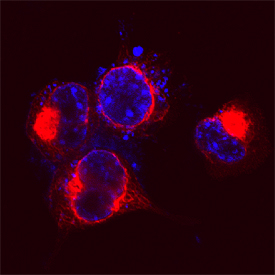Human/Mouse GSAP Antibody Summary
Arg737-Leu858
Accession # Q3TCV3
Applications
Please Note: Optimal dilutions should be determined by each laboratory for each application. General Protocols are available in the Technical Information section on our website.
Scientific Data
 View Larger
View Larger
Detection of Human and Mouse GSAP by Western Blot. Western blot shows lysates of HepG2 human hepatocellular carcinoma cell line and Hepa 1-6 mouse hepatoma cell line. PVDF membrane was probed with 1 µg/mL of Sheep Anti-Human/Mouse GSAP Antigen Affinity-purified Polyclonal Antibody (Catalog # AF8037) followed by HRP-conjugated Anti-Sheep IgG Secondary Antibody (Catalog # HAF016). A specific band was detected for GSAP at approximately 98 kDa (as indicated). This experiment was conducted under reducing conditions and using Immunoblot Buffer Group 1.
 View Larger
View Larger
GSAP in Neuro‑2A Mouse Cell Line. GSAP was detected in immersion fixed Neuro-2A mouse neuroblastoma cell line using Sheep Anti-Human/Mouse GSAP Antigen Affinity-purified Polyclonal Antibody (Catalog # AF8037) at 1.7 µg/mL for 3 hours at room temperature. Cells were stained using the NorthernLights™ 557-conjugated Anti-Sheep IgG Secondary Antibody (red; Catalog # NL010) and counterstained with DAPI (blue). Specific staining was localized to cell membranes. View our protocol for Fluorescent ICC Staining of Cells on Coverslips.
Reconstitution Calculator
Preparation and Storage
- 12 months from date of receipt, -20 to -70 °C as supplied.
- 1 month, 2 to 8 °C under sterile conditions after reconstitution.
- 6 months, -20 to -70 °C under sterile conditions after reconstitution.
Background: GSAP
GSAP (GSAP/gamma-Secretase Activating Protein; also known is Pion) is a member of the GSAP family of proteins. It is expressed in neurons, and purportedly serves as a regulator for g-secretase processing of APP. Initially, it was thought that cytosolic g-secretase mediated the second cleavage step in APP processing. In the presence of GSAP, APP (now C99 after b-secretase cleavage) was preferentially cleaved between either Val40-Ile41, or Ala42-Thr43, generating Ab40 and Ab42, respectively. In the absence of GSAP, APP would be preferentially cleaved between L49-Val50. Notably, the presence of GSAP was shown to have no effect on g-secretase processing of Notch. Subsequent studies have introduced uncertainty into these relationships. While an absence of GSAP does apparently reduce Ab production, its presence may not have the regulatory effect once proposed. Mouse GSAP-16K (15-17 kDa) is 121 amino acids (aa) in length (aa 738-858) (SwissProt #:Q3TCV3), it presumably represents a proteolytic cleavage product of the large 95-100 kDa, 858 aa GSAP-FL termed also Pion/pigeon homolog protein. There are no readily identifiable structural motifs associated with the molecule. Mouse PION has two isoform variants associated with the gene. One possesses a Phe substitution for aa 172-858, while another possesses a six aa substitution for aa 527-858. Over aa 737-858, mouse GSAP shares 94% and 88% aa sequence identity with rat and human GSAP, respectively.
Product Datasheets
FAQs
No product specific FAQs exist for this product, however you may
View all Antibody FAQsReviews for Human/Mouse GSAP Antibody
There are currently no reviews for this product. Be the first to review Human/Mouse GSAP Antibody and earn rewards!
Have you used Human/Mouse GSAP Antibody?
Submit a review and receive an Amazon gift card.
$25/€18/£15/$25CAN/¥75 Yuan/¥2500 Yen for a review with an image
$10/€7/£6/$10 CAD/¥70 Yuan/¥1110 Yen for a review without an image

